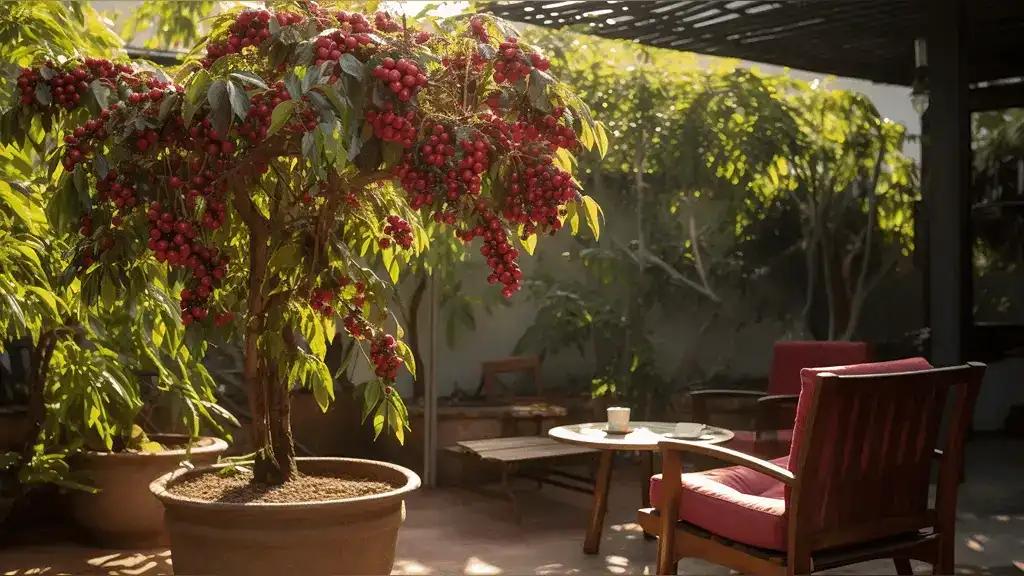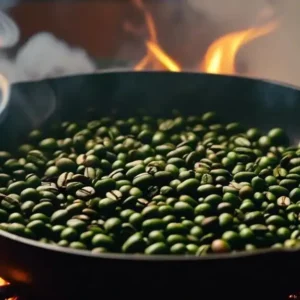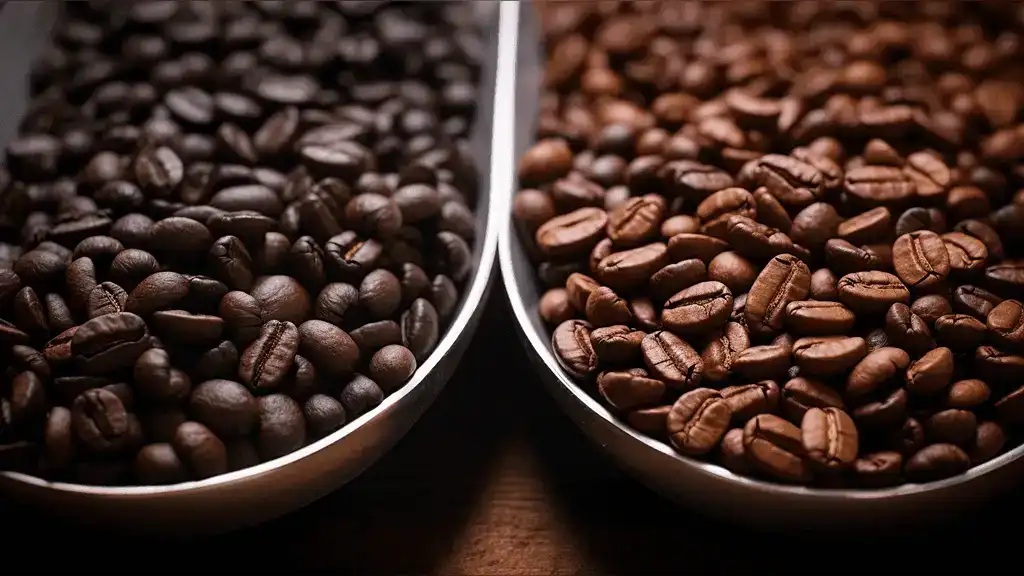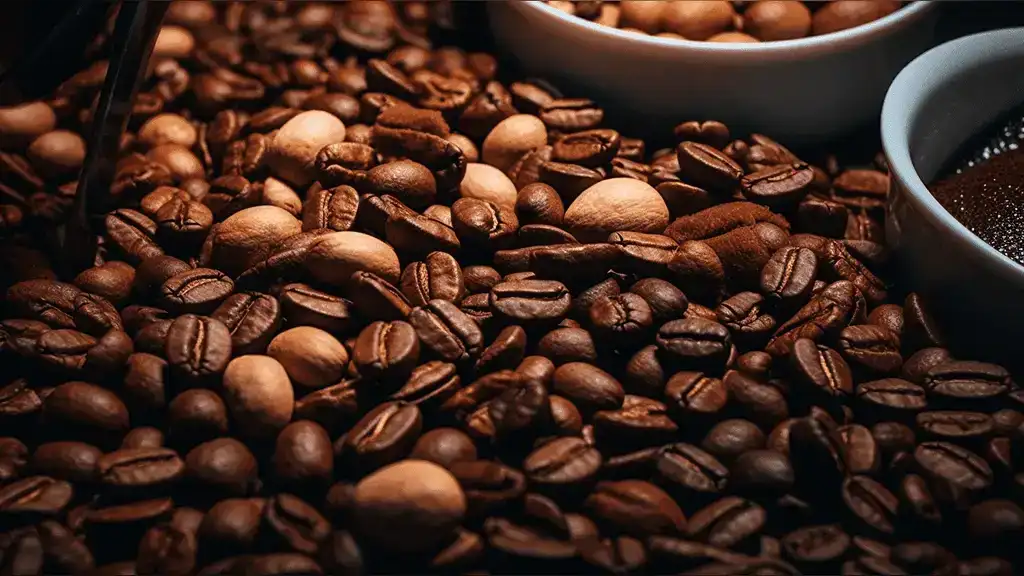Are you curious about the unique qualities of Excelsa coffee? Look no further, as this article delves into the distinct plant structure, rich flavors, captivating aroma, and lingering aftertaste that define Excelsa brews.
For those intrigued by the historical journey of Excelsa coffee, diving into its rich history and flavor can provide a deeper appreciation. Discover how Excelsa coffee has evolved over the years and the stories that shaped its unique traits.
Discover how Excelsa’s caffeine levels compare to other popular coffee species, and gain insights into the acidity and distinctive mouthfeel of this exquisite coffee.
With recommendations on brewing techniques and the role of Excelsa in coffee blends, you’ll be able to fully appreciate the complexity and quality of Excelsa beans.
The Botanical Makeup of Excelsa Coffee
If you’re wondering about Excelsa coffee characteristics, one distinct feature is its unique plant structure and bean morphology. Unlike other coffee varieties, Excelsa plants have a taller and more vine-like habit, which allows them to grow up to 20 feet in height.
The leaves of the Excelsa coffee plant are dark green and elongated, giving the plant an elegant and graceful appearance. This unique plant structure contributes to the coffee beans’ distinct flavor profile.
In terms of bean morphology, Excelsa coffee beans are also quite unique. They are medium-sized, elongated, and asymmetrical in shape.
Unlike the more common oval-shaped coffee beans, the Excelsa beans have a curved appearance, resembling the shape of a cashew nut. This distinct shape adds to the visual appeal of the beans.
When it comes to flavor, the unique plant structure and bean morphology of Excelsa coffee play a significant role. The beans have a complex flavor profile, characterized by a balance of fruity and earthy notes.
The taste is often described as having hints of tartness, with notes of dark fruits, like plum or black cherry, as well as a subtle nuttiness.
While Excelsa offers a unique taste profile, it’s fascinating to compare it with other coffee varieties. Explore the differences between Liberica and Excelsa and discover how each brings a unique flavor to the coffee world.
The Flavor Profile: A Symphony of Tastes
Exploring the deep and complex flavors of Excelsa coffee reveals a rich and unique taste experience. When you take your first sip, your taste buds are greeted with a burst of vibrant and tangy notes that dance across your palate.
The flavors of Excelsa are often described as fruity and wine-like, with hints of dark berries and a subtle acidity that adds brightness to the overall profile.
For those eager to delve deeper into the sensory experience, understanding what Excelsa truly tastes like can be a delightful exploration. Dive into a detailed analysis of its flavor notes.
As you continue to savor the coffee, you’ll notice a deep and earthy undertone that adds depth and complexity to the flavor. This is complemented by a smooth and velvety mouthfeel that coats your tongue, leaving a lingering richness that is both satisfying and comforting.
The unique taste of Excelsa coffee is a result of its distinct growing conditions. The coffee beans are grown in regions with high altitudes and a tropical climate, which contributes to the development of intense flavors.
The regions where Excelsa thrives play a pivotal role in its flavor development. Dive into the specific growing zones of Excelsa coffee and understand how terroir influences its taste.
The combination of the unique plant structure and bean morphology mentioned earlier further enhances the complexity of the taste.
Whether you prefer your coffee black or with a splash of milk, Excelsa coffee is sure to delight your senses with its deep and complex flavors. While Excelsa is a delight on its own, comparing it with other varieties can be enlightening. Explore the comparison between Excelsa and Arabica and understand the nuances that set them apart.
So take a moment to indulge in this exceptional coffee and experience a taste like no other.
Aroma and Aftertaste: Excelsa’s Sensory Delight
When you take a deep inhale of Excelsa brew, the captivating aroma fills your senses and lingers in the air. It’s a sensory experience that is unique to this particular coffee variety.
Excelsa is known for its distinct fragrance, which is often described as a combination of floral, fruity, and nutty notes. As you breathe in the aroma, you can almost imagine yourself strolling through a garden, surrounded by vibrant flowers and ripe fruits.
This captivating aroma is just the beginning of the Excelsa coffee experience. Once you take that first sip, you’ll notice the complex flavors that make this brew truly special.
The taste of Excelsa is often described as bold and full-bodied, with hints of tartness and a pleasing acidity. It’s a coffee that is both rich and balanced, offering a depth of flavor that is sure to satisfy even the most discerning coffee connoisseur.
To give you a better understanding of the unique characteristics of Excelsa coffee, here is a table showcasing some of its key attributes:
| Aroma | Flavor | Acidity |
|---|---|---|
| Floral | Bold and full-bodied | Pleasing acidity |
| Fruity | Tartness | Balanced |
| Nutty | Rich |
As you can see, Excelsa coffee offers a delightful combination of fragrance, flavor, and acidity. It’s a brew that is sure to awaken your senses and leave a lasting impression. So go ahead, indulge in a cup of Excelsa and experience the captivating aroma and lingering aftertaste for yourself.
Caffeine Content: How Excelsa Coffee Stacks Up
Excelsa coffee has lower caffeine levels compared to other popular coffee species. If you’re someone who loves the taste of coffee but wants to reduce your caffeine intake, Excelsa coffee might be the perfect choice for you.
Beyond its unique flavor and caffeine content, Excelsa coffee offers numerous benefits. Discover the remarkable benefits of Excelsa coffee and how it can enhance your overall coffee experience.
With its distinct flavor profile and lower caffeine content, it offers a unique and satisfying coffee experience.
When compared to other popular coffee species like Arabica and Robusta, Excelsa coffee stands out for its milder caffeine kick. This makes it a great option for those who are more sensitive to the effects of caffeine or simply prefer a more moderate caffeine buzz.
The comparison doesn’t end with Arabica. Dive deeper into the coffee world and explore the differences between Excelsa and Robusta, two varieties with distinct characteristics.
You can still enjoy the rich and flavorful taste of coffee without worrying about the jitters or the crash that can come with higher caffeine levels.
But don’t let the lower caffeine content fool you – Excelsa coffee still packs a punch when it comes to flavor. It boasts a complex and fruity taste, with hints of dark chocolate and a subtle acidity that adds brightness to each sip.
For those curious about the specifics, a detailed caffeine breakdown of Excelsa coffee can provide insights into its milder caffeine content.
Whether you prefer your coffee black or with a splash of milk, Excelsa coffee is sure to delight your taste buds and keep you coming back for more.
Acidity and Mouthfeel: A Textural Experience
If you’re someone who enjoys a coffee with a unique mouthfeel and a balanced acidity, you’ll appreciate the distinctive qualities of Excelsa coffee. Here are four reasons why Excelsa stands out among other coffee varieties:
- Mouthfeel: Excelsa coffee offers a mouthfeel that is often described as velvety and smooth. When you take a sip, you can feel the rich texture coating your palate, providing a delightful sensory experience.
- Acidity: Excelsa coffee strikes a perfect balance between acidity and sweetness. It has a bright, lively acidity that brings a refreshing tang to each cup, while still maintaining a smooth and enjoyable flavor profile.
- Complexity: The flavor profile of Excelsa coffee is complex and intriguing. It offers a unique combination of fruity, floral, and nutty notes, creating a captivating taste that evolves with each sip.
- Versatility: Whether you enjoy your coffee black or with milk, Excelsa coffee adapts well to different brewing methods and serving styles. Its robust flavors shine through, making it a versatile choice for any coffee lover.
Next time you’re looking to explore new coffee flavors, give Excelsa a try. Its distinctive mouthfeel, balanced acidity, complex flavors, and versatility make it a truly remarkable coffee experience.
The Color and Crema of Excelsa Coffee Brews
The appearance of a well-brewed cup of Excelsa coffee can be visually stunning, with a rich crema that adds a touch of elegance to the experience. As you pour the hot liquid into your favorite mug, you’ll notice the deep brown color and the velvety texture of the crema floating on top. It’s like a work of art in a cup.
To further understand the visual characteristics of Excelsa coffee, let’s take a look at the table below:
| Characteristic | Description |
|---|---|
| Color | Deep brown |
| Crema | Rich and velvety |
| Clarity | Clear and clean |
The color of a well-brewed cup of Excelsa coffee is a deep brown, giving it a warm and inviting appearance. The crema, which is the layer of foam on top, is rich and velvety, providing a luxurious feel to each sip.
As you observe the cup, you’ll notice the clarity of the coffee, which is clear and clean, indicating a well-extracted brew.
Roasting Excelsa Beans: A Delicate Art
Insights into how roasting brings out the best features of Excelsa can be found in the tailored process. When it comes to Excelsa coffee, the roasting process plays a crucial role in enhancing its unique characteristics. Here’s how the skilled roasters bring out the best in Excelsa:
- Medium Roast: The medium roast is often preferred for Excelsa coffee. It strikes the perfect balance between preserving the coffee’s distinct flavor notes and developing the desired richness. The beans are carefully monitored during the roasting process to ensure an even and consistent roast.
- Caramelization: Roasting brings out the natural sugars present in the Excelsa beans. As the beans are heated, these sugars caramelize, resulting in a delightful sweetness and depth of flavor. The roasters carefully control the temperature and time to achieve the perfect level of caramelization.
- Aromatics: Excelsa coffee is known for its complex and intriguing aromatics. The roasting process helps to intensify these aromas, filling your senses with tantalizing scents of floral, fruity, and nutty notes. The roasters use their expertise to bring out the full spectrum of aromatics while ensuring a well-balanced cup.
- Acidity and Body: Roasting impacts the acidity and body of the coffee. For Excelsa, roasting is tailored to preserve its naturally vibrant acidity while adding body and smoothness. The roasters carefully adjust the roast profile to achieve the desired balance, resulting in a cup that is both lively and satisfying.
Brewing Methods Best Suited for Excelsa Coffee
When brewing Excelsa coffee, it’s important to use techniques that enhance its inherent qualities.
To begin, grind your Excelsa coffee beans to a medium-coarse consistency. This ensures that the flavors are extracted optimally during the brewing process.
Next, use water that is fresh and filtered. The quality of the water can greatly impact the taste of your coffee, so it’s crucial to use clean and pure water.
When it comes to brewing methods, a French press or a pour-over method works best for Excelsa coffee. These methods allow for a longer extraction time, which brings out the unique flavors and aromas of Excelsa.
Additionally, be mindful of the water temperature. For Excelsa coffee, it’s best to use water that is around 195 to 205 degrees Fahrenheit.
Lastly, give your coffee enough time to bloom. This is a crucial step that allows the coffee to release its flavors fully.
By following these techniques, you’ll be able to brew Excelsa coffee that truly showcases its inherent qualities.
Enjoy your cup of rich and flavorful Excelsa coffee!
Excelsa in Blends: Enhancing Coffee Complexity
To fully appreciate the flavor complexity and unique contribution of Excelsa in coffee blends, you should experiment with different ratios and brewing methods. Excelsa, with its distinct taste profile, adds depth and character to any blend.
Here are four ways Excelsa enhances coffee blends:
- Complexity: Excelsa brings a new dimension to the flavor profile of coffee blends. Its fruity and tart notes add a refreshing twist, balancing the richness of other beans.
- Acidity: Excelsa’s natural acidity brightens the overall taste, creating a vibrant and lively cup. It adds a pleasant tang that complements other beans in the blend.
- Body: Excelsa contributes to the body of the coffee, giving it a fuller and more rounded mouthfeel. Its medium body adds substance without overpowering the blend.
- Aromatics: Excelsa’s unique aroma enriches the sensory experience. Its floral and nutty notes create an enticing fragrance, enhancing the overall enjoyment of the coffee.
By experimenting with different ratios of Excelsa in your blends and trying various brewing methods like pour-over or French press, you can unlock the full potential of this coffee bean.
The Role of Terroir in Shaping Excelsa’s Characteristics
Geographical factors play a significant role in influencing the taste and quality of Excelsa beans. The unique flavors and characteristics of Excelsa coffee are shaped by the specific environmental conditions in which the beans are grown.
As a coffee lover, you may already know that coffee beans from different regions have distinct flavors, and Excelsa is no exception. The altitude, climate, soil composition, and even the surrounding vegetation all contribute to the final taste profile of the beans.
In regions with higher altitudes, Excelsa beans tend to develop a more complex and vibrant flavor. The cooler temperatures and increased exposure to sunlight at higher elevations result in slower maturation and a longer growing season.
This allows the beans to develop more sugars and acids, resulting in a more pronounced acidity and fruity notes in the cup.
Furthermore, the soil composition in which Excelsa beans are grown can also impact their taste. Volcanic soils, for example, are known to enhance the richness and depth of flavor in coffee beans.
The minerals present in volcanic soil can impart unique characteristics, such as earthiness or hints of cocoa, to the final cup.
Lastly, the surrounding vegetation plays a role in the taste of Excelsa beans. Coffee plants grown in areas with a diverse range of plants and trees can benefit from the cross-pollination and exchange of nutrients. This can result in more complex flavors and a greater depth of aroma in the beans.
The allure of Excelsa coffee is deeply rooted in its origins. Embark on a journey to trace the roots of Excelsa coffee and understand the history that shaped its unique profile.
Conclusion
In conclusion, Excelsa coffee offers a unique and captivating experience for coffee enthusiasts. With its distinct plant structure and bean morphology, Excelsa stands out among other coffee species. Its rich and complex flavors, captivating aroma, and lingering aftertaste make it a favorite among coffee lovers.
Additionally, Excelsa’s caffeine levels, acidity, and mouthfeel contribute to its overall appeal. By understanding and utilizing the roasting process and brewing techniques tailored to enhance Excelsa’s inherent qualities, one can fully appreciate the depth and complexity of this exceptional coffee.
Furthermore, Excelsa’s role in coffee blends and its contribution to flavor complexity cannot be underestimated. Lastly, geographical factors play a crucial role in influencing the taste and quality of Excelsa beans, adding to its allure.
So, whether you’re a seasoned coffee connoisseur or just beginning your coffee journey, don’t miss out on the exceptional characteristics of Excelsa coffee.





















